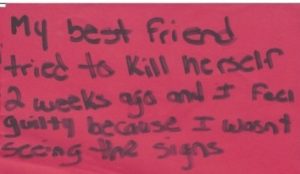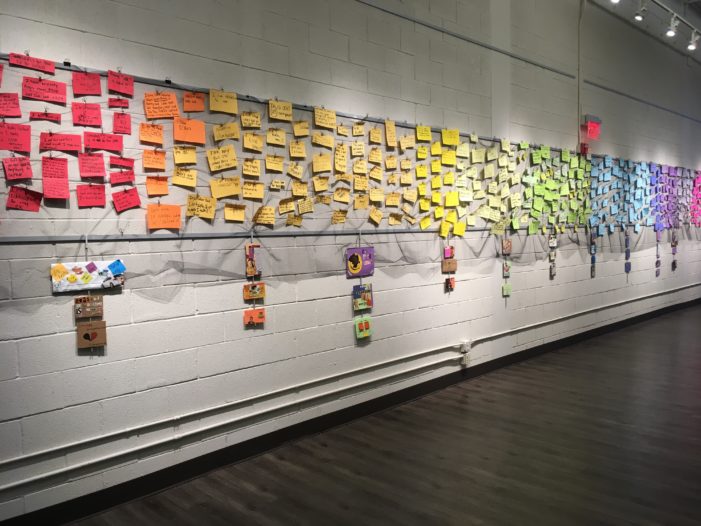By Megan Kelley
Review Writer
On Oct. 11, 2018 students at Renaissance High School in Detroit entered the building to find dozens of “secrets” taped to the wall.
The wall, now known as the “Coming Out Wall,” featured secrets students had anonymously submitted to the school’s LGBTQ (lesbian, gay, bisexual, transgender and questioning) Alliance as a way to bring unity and empathy to the student body.
Renaissance High School’s LGBTQ Alliance is led by 2008 Lake Orion graduate Kyle Goodall.
Goodall and his students found inspiration for the project through Frank Warren, the creator of PostSecret – a global scale version of the same idea.
“Secrets can take many forms. They can be shocking or silly or soulful. They can connect us to our deepest humanity or with people we’ll never meet,” Warren said in his 2012 TED Talk “Half a Million Secrets.” At that time, he had garnered over half a million anonymous secrets from all over the world and today his website postsecret.com has over 819,000,000 visits.
The secrets disclosed by students at Renaissance High School ranged from teen angst to sexuality and mental health issues. Issues that affect high school students everywhere — issues that are difficult, if not impossible, for them to speak openly about.
 There were 225 posts submitted and at its height, three walls had been transformed. Ninety-one students revealed that they were distressed in some way and 29 came out as LGBTQ.
There were 225 posts submitted and at its height, three walls had been transformed. Ninety-one students revealed that they were distressed in some way and 29 came out as LGBTQ.
The Coming Out Wall quickly became a fixture in the school. Students took extended bathroom breaks or detours to their next class to read for themselves the things their fellow classmates were revealing. Within hours submissions were flooding in.
Despite the overwhelmingly positive response from the students, some of the school’s administration raised concerns about the contents of the wall and how parents and young students would take it and demanded that the wall be removed.
Students prepared to walk out of class in protest over the walls’ removal.
“But the principal stood her ground…she paused for a moment and said, ‘No, I said the wall could stay up. I approved it, it’s staying up. We’ll make modifications as necessary,’” Goodall said.
The early modifications to the wall included banning posts regarding sex, drugs or suicide, said Goodall.
As the tensions rose and rumors spread about the wall’s future in the school, students began their own acts of rebellion, putting up their own sticky-notes of affirmations for their struggling classmates and writing letters to Administration in favor of the wall, Goodall said.
“This wall was very significant and important to me because it gave students a voice,” one student wrote. “Administration has always tried to tell us that they were here but I have always felt like they weren’t. Mr. Goodall making this wall showed me and other students that we go through the same thing and we shouldn’t feel alone.”
“I think that the wall is positive for people. After the Coming Out Wall came out, my peers have been more supportive of each other,” wrote another student. “I imagine it’s ultimately a good coping mechanism for people. What people were afraid to say before, they can say now.”
Goodall saw the growing tension between students/faculty and administration and contacted Jay Kaplan, the LGBTQ lawyer for the ACLU of Michigan, feeling that it might be a First Amendment issue.
Kaplan found it problematic and suggested that the school update its policy about what can go up on walls so it’s consistent across the board, Goodall said.
Administration wanted the wall down after a week, while students fought for it to stay up for the whole year. A compromise was reached that on Oct. 31 the wall would be taken down.
Students then began to write letters in response to the notes that had been posted on the wall for a sort of “Dear Abby” style dialogue between peers.
Since then, the wall has been moved to Affirmations in Ferndale which includes all of the censored posts that were not allowed to go up at RHS and the student’s response letters.
 According to a 2016 study done by the CDC (Centers for Disease Control) suicide is the second most leading cause of death for children ages 15-19.
According to a 2016 study done by the CDC (Centers for Disease Control) suicide is the second most leading cause of death for children ages 15-19.
The wall itself helped confirm that LGBTQ students are at a higher risk of depression and suicide, said Goodall.
While RHS is one of the only schools in the state with an in-school LGBTQ support group, it was apparent that administration (much like other districts throughout the country) was not meeting the needs of their students.
RHS’s Principal saw the data that the wall garnered and decided to task two social workers with the job of finding a way to greater support the school’s students.
“Most of these issues are invisible and that’s why it’s so important that we make spaces for students to voice their concerns, voice grievances, voice pain, hurt, suffering. We have to be there for them. Just because we’re adults doesn’t mean we know how to be there for them, sometimes we need to let the kids let us know is how we can be there for them. I think the Coming Out Wall, since it was student-led, student-driven, it was just students, I think that made it abundantly clear,” Goodall said.
“I think other schools should try the Coming Out Wall and they can modify it…I think there are many ways to approach the wall, but as long as there’s a way to get folks honestly communicating their needs, that’s what’s important,” Goodall said.
The RHS Coming Out Wall can be viewed at Affirmations, located at 290 W. Nine Mile Rd. in Ferndale, until August and will be the official Pride exhibit this year.


Leave a Reply